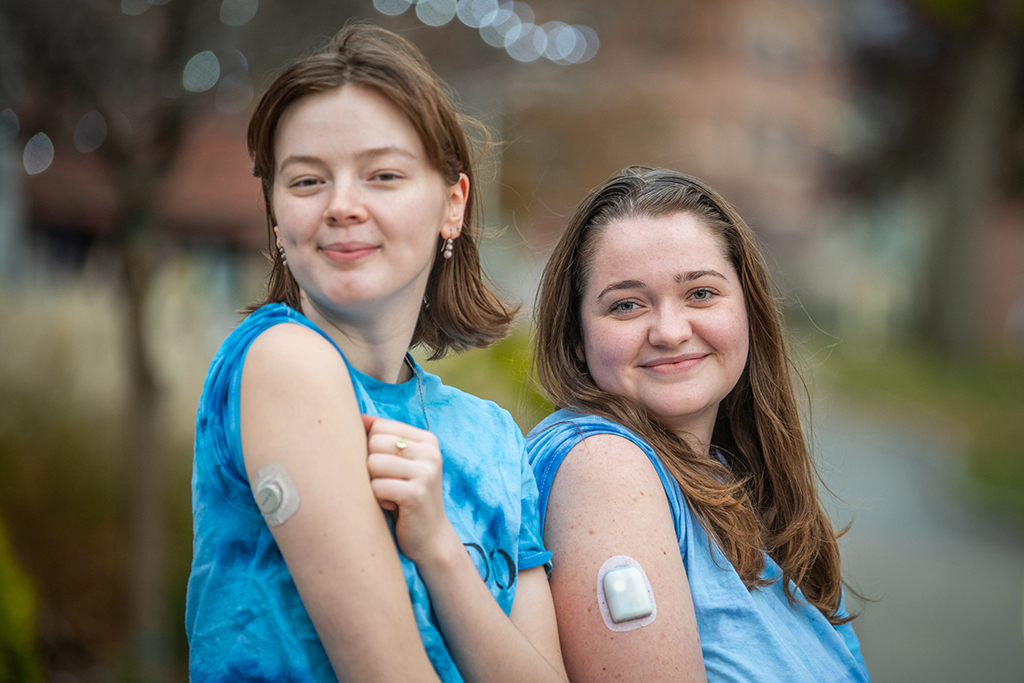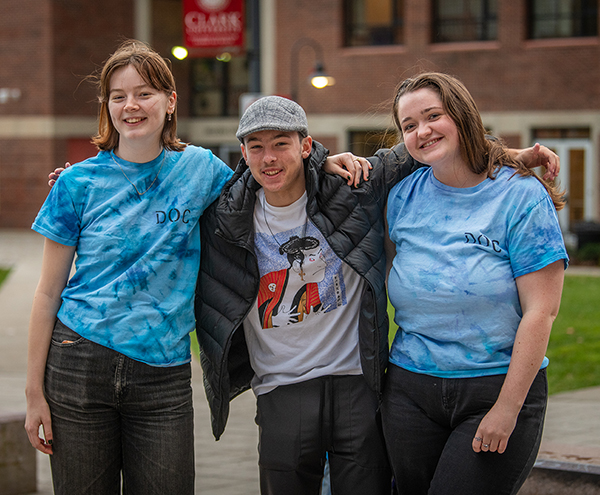‘I feel more seen and heard when my friends ask me about my life as a diabetic’

Grace Dowling ’24 was working at her on-campus job when another student stopped in front of her desk and asked a question.
“Are you diabetic?”
As a matter of fact, Dowling told her fellow Clarkie, she is.
The question wasn’t really a surprise. Dowling, who was diagnosed with Type 1 diabetes at age 16, wears a continuous glucose monitor (CGM) on her arm, and the other student — also a Type 1 diabetic — noticed.
Dowling took the opportunity to share information about Diabetics of Clark, a student organization founded in 2021. She and Aine Sheehan ’24 are co-chairs, and there are 15 members, all of whom have Type 1 diabetes.
Type 1 diabetics make up a small percentage of diabetes patients in the U.S. — just 5-10%. That works out to about .55% of the U.S. population. Diabetics of Clark comprise .6% of undergraduate students at Clark University.
Originally known as juvenile diabetes, Type 1 diabetes is thought to be caused by an autoimmune reaction that destroys the beta cells in the pancreas that make insulin, an essential hormone that helps your body turn food into energy and manage blood sugar levels. Once the pancreas stops making insulin, it can’t be reversed; there is no cure, only management. People with Type 1 diabetes must inject themselves with insulin to survive and to help their bodies use the carbohydrates they ingest, but it must be the right amount — too little insulin could lead to hyperglycemia (high blood sugar) and diabetic ketoacidosis, which can require emergency assistance; too much insulin could result in hypoglycemia (low blood sugar).
Hypoglycemia can be unpredictable. That’s why, since Diabetics of Clark was founded by Becca Burnett ’22 and Maire O’Donnell ’23, the club has been working on a major project: the installation of several “emergency low stations” on campus.
To counteract a low blood sugar, diabetics must consume a fast-acting carbohydrate like juice, glucose tablets or gel, or candy that doesn’t have much fat or protein to slow absorption. The members of the club usually carry supplies with them, but if they find themselves on campus with no way to treat a low, they’d rather avoid having to call an EMT. The low stations would be filled with single-serve sources of glucose and would be easily accessible in central locations across campus.
“We’re all passionate about the low stations project,” Sheehan says. “Many of us have had scary lows, and it would be reassuring to know they were there.” The club is currently working with Facilities Management to finalize the low station locations.

Dowling and Sheehan struggle to describe how it feels to have low blood sugar — classified as dropping below the normal range of 70 to 100 milligrams per deciliter. This means that the brain does not have enough glucose to function properly.
“It’s different for everybody,” says Sheehan, who was diagnosed at age 11. “I get foggy-brained and irritable, and feel like everything’s been drained out of me. It’s hard to talk and explain myself in those moments.”
“I get physically weak and tired, and emotionally exhausted,” Sheehan says.
On the other side, high blood sugar — which can damage the blood vessels in the brain — has its own symptoms.
“For me, when my blood sugar is high, it takes me longer to process what’s happening or what’s being said to me. I might have headaches or get confused,” Dowling says.
“I get extremely tired and irritable, and I have trouble catching my breath, which can trigger anxiety — which itself can cause a high blood sugar,” Sheehan says. “It’s a loop.”
Joining Diabetics of Clark helped Sheehan learn how to break out of that loop. “Our co-founder, Becca, told me that when she was working in the library and had a high number, she ran up and down the stairs for a while. That kind of movement can really help bring a number down,” Sheehan says. But exercise can also cause a low blood sugar.
“Diabetes is a constant balancing act,” Dowling says. “You can have several days of the back and forth of high and low.” Being part of the Diabetics of Clark group helps her remember that it’s all right to feel tired and burned out sometimes.
“It’s having a community that understands you in a way that no one else can,” Sheehan says. “Type 1 is a big part of our lives, whether we embrace it or try to forget it, and it’s great to have people who genuinely do understand.”
Arielle Silver ’25, co-social media chair for the group, says she wants her peers to know how complicated Type 1 diabetes is. “Many people think we just ‘can’t eat sugar,’ or just have to monitor our carb intake, yet it is much more. Stress and exercise — and so many other factors — affect your blood sugar. There is never a time when your brain can rest and not think about it, or it could cost you your life.
“I will never look at food the same anymore because my ability to eat freely — without thinking about it and analyzing it — was stripped from me. It’s especially difficult to know life before and that things will never be the same,” Silver says.
“We can rant without having to explain ourselves, and we can make light of some of the harder things we have to go through, because we all know,” Sheehan says. “The club also reminds us of other resources that we may need, especially when we’re talking about mental health and diabetes.” The CDC reports that people with diabetes are two to three times more likely to have depression than people without the disease, and 20% more likely to have anxiety.
Dowling says her peers shouldn’t be afraid to ask her or other club members about their experiences.
“While I understand where the hesitance comes from, I think that my life as a Type 1 diabetic would honestly be better and simpler if the people around me understood me more,” she says. “Most of us would be more than happy to help you understand our condition better. It can be an exhausting and consuming condition to have, but it is a large part of who we are, and I think for me, at least, I feel more seen and heard when my friends and peers ask about what my life is like as a diabetic.”
Melissa Lynch is the advisor for the Diabetics of Clark student group.


